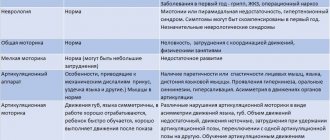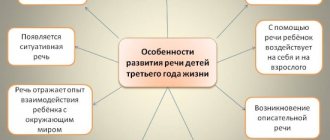Dyslalia in children is distortion or omission of sounds with normal hearing and the absence of pathologies. There are several types of disease:
- Mechanical – caused by pathologies of the organs of the articulatory apparatus.
- Functional – caused by a child’s imitation of an adult’s incorrect speech (tongue-tied, lisping, etc.) or disturbances in the cerebral cortex.
- Monomorphic - a violation of the pronunciation of sounds from one group (S-Z-C or Sh-Zh-Ch).
- Polymorphic – violation of the pronunciation of sounds from different groups (S-R-K-SH).
Causes
The cause of the development of mechanical dyslalia is organic defects in the anatomical structure of the peripheral articulatory apparatus, which includes: jaws, teeth, lips and tongue.
Among the anomalies of the articulation apparatus leading to dyslalia, the most common are:
- short frenulum of the tongue or upper lip;
- macroglossia - massive, tongue;
- microglossia - narrow, small tongue;
- thick, inactive lips;
- malocclusion: deep, cross, open;
- anomalies of the dentition: diastemas, sparsely located or small;
- high narrow or low flat upper palate.
Anatomical defects that cause mechanical dyslalia can be congenital or occur as a result of diseases and injuries of the dental system.
With functional dyslalia, the structure of the articulatory apparatus is not changed, i.e., there is no organic basis for the violation of sound pronunciation.
In this case, the causes of dyslalia are social or biological factors:
- pedagogical neglect;
- "lisping" of adults when talking to children;
- tongue-tied, hasty speech of others;
- bilingualism in the environment;
- minimal brain dysfunction;
- general physical weakness.
Prevalence of the problem
The disease is a common occurrence, most common in the practice of speech therapists.
According to various estimates, the average number of children with such problems in preschool age is 25-30%, in elementary grades – 17-20%, and in older age – 1%. Classes with a speech therapist are also required for adults who have suffered strokes, TBI, or multiple sclerosis. Most often, there are combined disorders of sound pronunciation that prevent further mastery of written speech. At the same time, the vocabulary can be replenished according to age, all cases are used correctly, the structure of syllable formation is not disrupted, speech is developed at a high level.
Symptoms
Four types of sound pronunciation defects in dyslalia: omissions, substitutions, confusion and distortion of sounds.
By skipping a sound we mean its complete loss in one position or another: at the beginning, in the middle or at the end of a word.
Sound replacement is a persistent replacement of one sound with another, also present in the phonetic system of the native language. Sound substitutions are caused by the failure to distinguish phonemes based on subtle articulatory or acoustic features. With dyslalia, sounds can be replaced that differ in place of articulation or method of formation, on the basis of sonority-voicelessness or hardness-softness.
They talk about mixing sounds if two correctly pronounced sounds are constantly confused in the speech stream, that is, their use is either appropriate or inappropriate.
Distortion of sounds is an irregular pronunciation, the use in speech of sounds that are absent in the phonetic system of the Russian language. For example, velar or uvular pronunciation [r], interdental or lateral pronunciation [s] and others. Distortion of sounds is usually found in mechanical dyslalia.
With functional dyslalia, as a rule, the pronunciation of one or more sounds is impaired; in the case of mechanical dyslalia - a group of sounds similar in articulation. Thus, an open anterior bite will contribute to the interdental reproduction of the sounds of anterior lingual articulation [z], [s], [ts], [h], [zh], [sh], [sch], [d], [t], [l ], [n], because the tip of the tongue cannot be held behind the front teeth.
Characteristics of the defect
When diagnosing acoustic-phonemic dyslalia, three forms of phoneme pronunciation disorders are distinguished:
- Sound skipping. For example, “house - om”. The baby skips the first syllable because he doesn’t hear it. This form of disorder is rare.
- Replacing phonemes. At the same time, the child’s articulation is correct, all sounds are pronounced clearly. An example of such a substitution: “rice” - “fox”, “bil” - “drank”. In this case, the replacement can be selective, when the child replaces only sibilant (zh - sh) or sonorant (l - r) consonants. Such a violation indicates an incorrect formation of the phonetic-phonemic system.
- Confusion in sounds. The child distinguishes phonemes, however, when pronouncing them, he replaces one with another, choosing from phonetic groups that are similar in articulation.
Children with dyslalia have difficulty communicating. The baby pronounces words incorrectly, so it is difficult for others to understand him, and in addition, he is not always able to correctly recognize someone else's spoken speech.
In written speech, the defect does not always appear. Children can write dictations without errors, but allow them in creative (essays, presentations) works.
Diagnostics
A speech therapist examines the structure and mobility of the organs of the articulatory apparatus through visual inspection and using special test exercises.
In the process of a speech therapy examination, the nature of the disorder is revealed, namely the absence, replacement, mixing and distortion of sounds in various positions - in isolation, in open, closed or consonant syllables, words at the beginning, middle or end, as well as phrases and texts.
Then the state of phonemic hearing is checked - the ability to auditory differentiate all correlating phonemes.
For mechanical dyslalia, a speech therapist can refer the patient for consultation to an orthodontist or dental surgeon, and for functional dyslalia, to a neurologist.
If hearing loss is suspected, a consultation with an otolaryngologist and a study of the function of the auditory analyzer is carried out.
Acoustic-phonemic dyslalia - definition
Dyslalia is translated from Greek as “speech and disorder.” Acoustic-phonemic dyslalia develops when phonemic hearing is impaired (immature), namely:
- inability to recognize and recognize sounds;
- inability to differentiate sounds of adjacent phonetic groups.
This defect is not associated with hearing aid pathologies. Acoustic-phonemic dyslalia is based on selective impairments in the ability to distinguish phonemes in oral speech and reproduce sounds correctly.
Patients with phonemic disorder have difficulty distinguishing sounds and recognizing them correctly. The composition of phonemes with such a defect is not completely formed. Because the baby misrecognizes the sound, he misunderstands the entire word. Example: a child does not understand the difference between the words “hole” and “bark”, “beetle” and “bough”.
Correction
Correction of dyslalia is usually divided into three stages:
- Preparatory stage. In case of mechanical dyslalia, at this stage it is necessary to eliminate anatomical defects in the speech-forming apparatus: orthodontic treatment, plastic surgery of the frenulum. For functional motor dyslalia, speech therapy massage and articulatory gymnastics are indicated. Treatment of sensory dyslalia begins with the development of phonemic processes.
- Formation of primary pronunciation skills. It includes the production of isolated sounds, their automation in words, syllables, sentences, as well as the differentiation of sounds.
- Formation of communication skills. At this stage, it is necessary to develop in the child the skills to correctly use the given sounds in any communication situations.
Speech therapy classes for the correction of dyslalia should be conducted regularly, at least three times a week. It is important that speech therapist tasks and articulation gymnastics are also performed at home.
Causes of the disorder and mechanism of development
Provoke the appearance of a defect:
- Physiologically incorrect formation of the maxillofacial system, mouth and nasopharynx. Anatomical abnormalities lead to incorrect articulation of entire groups of sounds. Children with an anterior bite have problems pronouncing sibilant consonants because it is difficult to hold the tongue behind the teeth.
- Despite normal physiological hearing indicators, children with acoustic-phonemic dyslalia have not developed a sensory understanding of oral speech. There is no recognition function, comparison of common and different features of phonemes, as a result of which the child perceives words incorrectly.
The main reason for such a speech disorder is the immaturity of phonemic hearing.
The child does not distinguish between sounds, so he replaces one with the other when pronouncing. Usually, the sounds of one acoustic group are replaced: sonorant, whistling, hissing, voiced or voiceless.
Who to contact
The main condition for the success of diagnosing and eliminating a speech disorder is the coordinated work of a neurologist and a speech therapist-defectologist. The doctor and speech therapist evaluate the specifics of fine motor skills and the functionality of the finger joints. If the cause of the disorder is a neurological pathology, then when planning correctional classes, the defectologist relies on the conclusion of a neurologist.
In order for the diagnosis to be made correctly, it is important to reassure the child. Because nervousness, crying or fear increase muscle tone, which distorts information about the baby’s speech and motor abilities.
Article on the topic: “Characteristics of dyslalia”
CHARACTERISTICS OF DYSLALIA
I dislali
comes from the Greek. the words dis - disorder and lalia - speech.
Dyslalia in children
: By the age of 4–5 years, sound pronunciation in most children reaches normal. However, all children are different, and some, for various reasons, continue to pronounce sounds incorrectly, and this becomes a habit.
Violation of sound pronunciation with normal hearing and intact innervation of the speech apparatus is called dyslalia
. This is one of the most common speech defects. According to some scientists, dyslalia occurs in approximately 25% of preschool children.
Causes of dyslalia
may be different, therefore it is customary to distinguish between mechanical (organic) and functional dyslalia.
Mechanical dyslalia
is a consequence of organic defects of the peripheral speech apparatus. The most common defect is a shortened frenulum of the tongue, which makes it difficult to move, not allowing it to rise high (with higher sounds). Sometimes the tongue is too large, it hardly fits in the mouth and, naturally, is clumsy; or too small and narrow, making articulation difficult.
Another cause of dyslalia is defects in the structure of the jaws, which lead to malocclusion. Occlusion is the location of the upper and lower dentition relative to each other. It is considered normal when the upper teeth slightly cover the lower teeth when the jaws are closed. The nature of the bite is of great importance for correct articulation - the physiological process of the formation of speech sounds. At 2.5 years old, the child develops a so-called milk bite, at 6 years old the replacement of milk teeth with permanent teeth (replaceable bite) begins, and by the age of 13–14 years a permanent bite is established. During the period of changing teeth, dental anomalies most often occur, so children should be periodically shown to the dentist.
Bite abnormalities can be of several types.
Prognathia –
The upper jaw protrudes significantly forward.
Progenia –
the lower jaw protrudes significantly forward.
Open bite
– a gap remains between the teeth of the upper and lower jaws when they close; contacts are preserved only on the far lateral teeth. The severity of the anomaly is determined by the size of the gap between the teeth, that is, the number of non-articulating teeth.
Lateral open bite can be left-sided, right-sided or bilateral.
Incorrect tooth structure can also lead to dyslalia, so if you have the slightest suspicion of a malocclusion in a child, you should seek advice and help from a dentist. Timely application of special splints to the teeth will lead to complete alignment of the bite and growth of teeth. It is best to apply splints at the age of 5–6 years, when the bones are still quite elastic.
The incorrect structure of the palate also affects sound pronunciation. A narrow, high palate or a low, flat palate interferes with the correct articulation of many sounds.
A drooping lower lip or a shortened, inactive upper lip makes it difficult to clearly pronounce labial and labiodental sounds.
For functional dyslalia
The child does not have any defects in the articulatory apparatus. One of the main causes of functional dyslalia is improper upbringing of the child in the family. Parents like the baby’s babbling and “babble” with him, which delays the development of correct sound pronunciation for a long time. This also includes the so-called pedagogical neglect, when parents do not pay any attention to the child’s incorrect pronunciation of sounds and do not correct him, do not develop his speech, which not only inhibits the normal development of pronunciation skills, but can also delay the overall development of the child.
Sometimes dyslalia can occur if a child has a younger brother or sister, and the older one begins to copy the speech of the younger one. In this case, it is necessary to explain to the child that, on the contrary, it is he, as the elder, who must teach the little one to speak correctly and set a good example for him. It's worse when one of the adults has unclear, tongue-tied or too fast speech. Such an example can be very harmful, and adults need to monitor their speech as much as possible.
Bilingualism in the family can affect the child’s sound pronunciation, since the child often transfers the pronunciation features of one language to another.
Underdevelopment of phonemic hearing in a child can become a serious problem. In this case, it is difficult for him to distinguish sounds that differ only in subtle acoustic features, for example, voiced and voiceless consonants, soft and hard whistling and hissing consonants. The development of correct sound pronunciation is very slow and sometimes leads to difficult formation of phonemic hearing, which subsequently causes difficulty in writing and reading.
Insufficient mobility of the organs of the articulatory apparatus (tongue, lips, lower jaw), the child’s inability to hold the tongue in the correct position or quickly change its position can also lead to dyslalia.
With hearing loss, there is difficulty in differentiating between whistling and hissing sounds, voiced and voiceless consonants.
Almost half of children suffering from insufficient mental development have impaired sound pronunciation.
Most often, with dyslalia, the pronunciation of whistling (s, z, ts), hissing (sh, zh, h, sch) and lingual (r, l) is impaired. Moreover, soft pairs of consonants r and l, as a rule, are pronounced correctly
.
Other sound pronunciation disorders appear:
- in the absence of certain sounds (apka - hat, paovoz - locomotive, ho - choir);
- distortion (now – losses, bicycle – powered, tree – devereaux);
- replacements
Substitutions may be as follows:
- “k” and “g” to “t” and “d” (tukhnya - kitchen, damak - hammock);
- “s” to “t” (wheelbarrow - net);
- “s” to “f” (fumka – bag);
- voiced sounds into unvoiced ones (pulka - roll, suby - teeth, trova - firewood, folosy - hair, krusha - pear, shara - heat);
- soft sounds are hard, and vice versa (ryaz - once, pula - saw).
Sound production stage.
The goal of this stage is to develop the initial skills of correctly pronouncing a sound and is achieved in two ways:
- By imitation;
- With mechanical assistance.
The production of sound with mechanical assistance depends on the characteristics of its articulation. Probes, spatulas, and probe substitutes can be used as mechanical assistance.
Video: setting the sound p
Important to remember! The production of sounds should be carried out by a speech therapist exclusively in the conditions of individual work with the child.
Dyslalia: classification, forms, types
Neurologists, neuropathologists, reflexotherapists , psychoneurologists, and speech therapists distinguish 2 main types of dyslalia: functional and organic. There are 3 main types of functional dyslalia: articulatory-phonetic, articulatory-phonemic, acoustic-phonemic.
Based on the number of disturbed types, experts distinguish 2 types of dyslalia: monomorphic and polymorphic. With monomorphic dyslalia, the pronunciation of 1 sound or one group of sounds is impaired; with polymorphic dyslalia, the pronunciation of two or more sounds or groups of sounds is impaired.
With dyslalia, one or another sound may not be pronounced, one sound may be replaced by another, pronounced in isolation, but absent or distorted in independent speech.
Dyslalia, correction of dyslalia, treatment of dyslalia in Saratov, Russia
Sarklinik provides treatment for dyslalia in Saratov , treatment for dyslalia in Russia in children, boys, girls, treatment for tongue-tiedness. Complex treatment allows you to normalize and improve the child’s speech, sounds are staged, special procedures are carried out. In the prevention of dyslalia, proper speech education in young children is important, when it develops most intensively. The younger the preschool child, the faster dyslalia is treated.
Sound automation stage.
Automation of sounds is carried out consistently, through repeated training. Sound automation procedure:
- Isolated utterance;
- In syllables:
- in straight syllables (consonant + vowel);
- in reverse syllables (vowel + consonant);
- between vowels (vowel + consonant + vowel);
- in conjunction with a consonant sound (consonant + consonant + vowel);
- In words;
- In phrases;
- In sentences;
- In the text;
- In tongue twisters, pure tongue twisters, in your own speech.
Video: sound automation L









